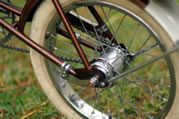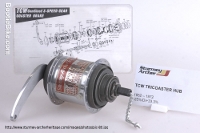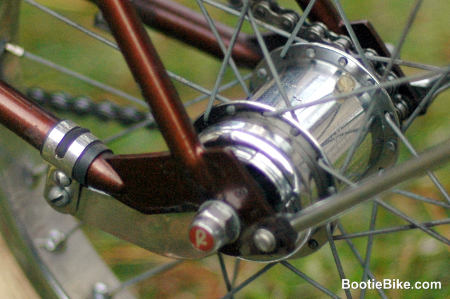Sturmey Archer TCW III three speed hub with coaster brake
A dissenting view
The RSW Mk II featured in Bootiebike is a 'colonial' model fitted with a Sturmey Archer TCW III three speed rear hub, with coaster brake, instead of the S3B with  mini drum brake that lived on most Mk II RSWs. I am aware that some people are very critical of the TCW. They complain that the available braking power varies, depending on which gear it's in, and it happens to be weakest in high, when you'll be going fastest. Secondly, the brake doesn't work at all if you've accidentally put the gears in 'neutral', the intermediate position between the normal and high positions on the trigger. They claim that for these reasons the TCW is unsafe and should not be used.
mini drum brake that lived on most Mk II RSWs. I am aware that some people are very critical of the TCW. They complain that the available braking power varies, depending on which gear it's in, and it happens to be weakest in high, when you'll be going fastest. Secondly, the brake doesn't work at all if you've accidentally put the gears in 'neutral', the intermediate position between the normal and high positions on the trigger. They claim that for these reasons the TCW is unsafe and should not be used.
But I beg to differ. I can't comment on the TCW marks I and II, but I can say that the TCW Mark III is safe and well worth using. Well made and finished, reliable and requiring little maintenance, it offers good service with minimal hassle. And the TCWIII is reliable. The oft-repeated criticisms outlined above usually cite reliability, but they're really about safety. (If there really were reliability issues, then they were certainly sorted by the time of the Mark III.)
Well, what about the safety? Granted, the TCW brake is weakest in high gear (and strongest in low). While this may not conform to the theoretical ideal, what really matters is whether or not it's powerful enough in high gear. And that it is. And further, the chances of needing to brake suddenly after accidentally shifting into neutral should be remote. Shifting into neutral should itself be a rare occurrence. If it happens often there is probably something wrong with the adjustment or cabling.  (Most SA hub problems are caused by external factors, rather than something in the unit itself, so perhaps you should consider learning how to adjust the gearchange.)
(Most SA hub problems are caused by external factors, rather than something in the unit itself, so perhaps you should consider learning how to adjust the gearchange.)
And most importantly, and at the risk of stating the bleedin' obvious, the above criticisms – if they had any validity at all – could only matter if one rode without a front brake. If you're at all concerned with safety you won't be totally reliant on a rear brake of any description.
So why should you care about the TCW, despite the doomsayers? To start with, it was made in the days when Sturmey Archer still cared about quality. The internal parts are finely machined and the case hardening is long lasting (unlike the hubs made in the 80s and 90s), and it has brass braking parts (steel in later models) for smooth and progressive braking. The TCW is well finished, with deep chrome plating, not just on the shell but also on the brake arm and left side dust cover. Compare that to the cheapo finishes on some later models.
The TCW also has the advantages of any coaster brake. For example, it requires minimal maintenance. This doesn't just save your spare time; it also means you can rely on it to work its best when you really need it. In contrast, caliper brakes require frequent maintenance and are less likely to be at their best. There's no messy cable or lever to worry about. No adjustments. They don't gouge the side of the rim, and they work when the rim is rusty, damaged, contaminated with oil or out of true. They don't get clogged up with road muck, and there's nothing to clean. And (for vintage bikes) they work in any weather – even the best caliper brake in the world is next to useless on a wet steel rim.
So take the criticism of the TCW with a fairly large grain of salt – they're really not that bad, and I think future generations will prize the few examples that survive their current demonisation. The TCW is a quality product, made to last. With a little care it'll continue giving good service indefinitely.

